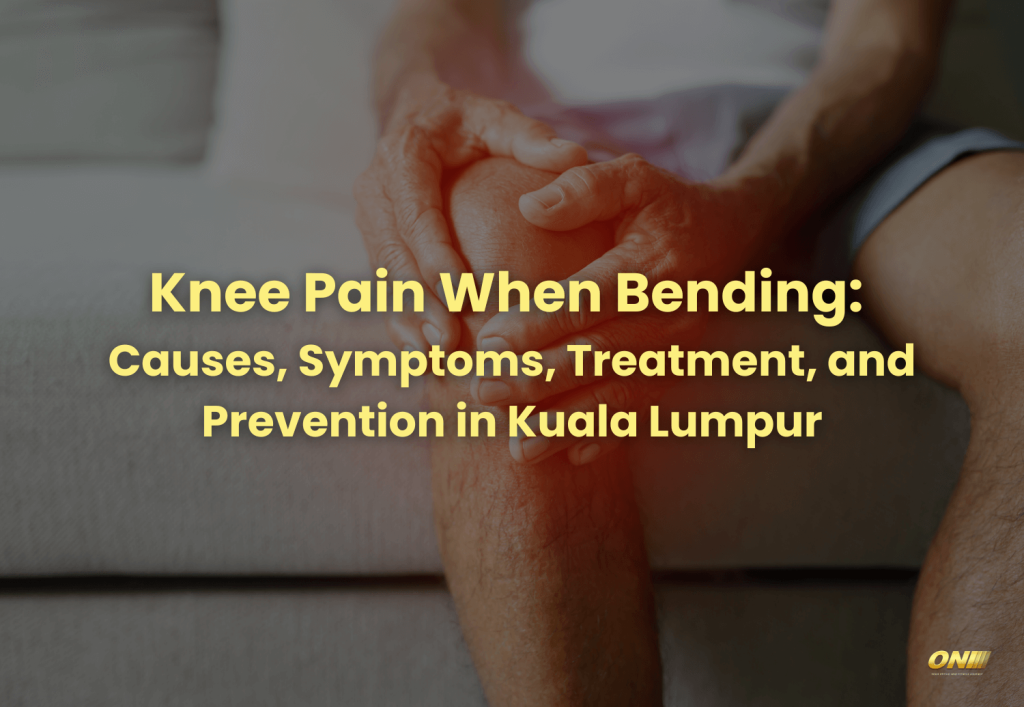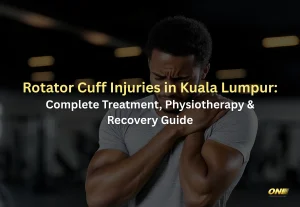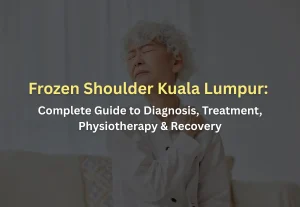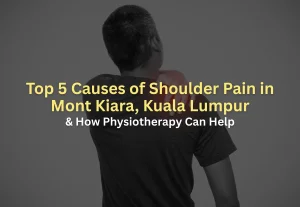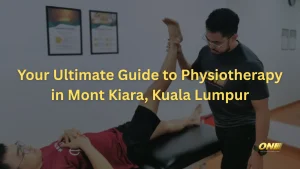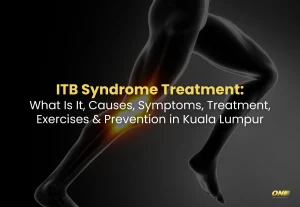Introduction
Knee pain when bending is a common complaint that can disrupt daily activities and limit physical activities. Whether it’s a mild discomfort or intense pain, knee issues shouldn’t be ignored as they can worsen over time. Various factors like aging, injuries, or underlying conditions could lead to knee pain when bending.
If you’re dealing with knee pain and reside around Mont Kiara or Kuala Lumpur, ONI Physio Fitness offers expert assessment and personalized treatment options to help you find relief.
Causes of Knee Pain When Bending
Knee pain when bending can be triggered by different causes, including:
- Patellar Tendinitis
Inflammation of the tendon connecting the kneecap to the shinbone, often seen in people who engage in high-impact activities like running or jumping. - Osteoarthritis
This degenerative condition wears down the knee joint cartilage, causing pain, especially when bending or weight-bearing. - Meniscus Tear
The meniscus is the cartilage between the thigh and shin bones. A meniscus tear, often due to sudden twisting, can cause pain and limited movement when bending the knee. - Bursitis
Bursitis is inflammation of the bursae, small sacs that cushion the knee joint. Overuse or trauma can lead to bursitis, which causes pain above the kneecap and restricts movement. - Ligament Injuries (ACL/MCL)
Injuries to the anterior cruciate ligament (ACL) or medial collateral ligament (MCL) are common in sports and can lead to severe pain and instability when bending the knee.
Symptoms of Knee Pain When Bending
Knee pain symptoms can vary based on the affected area:
- Above the Kneecap: Pain above the kneecap often indicates issues with the quadriceps tendon, patellar tendinitis, or bursitis.
- Behind the Knee: Pain at the back of the knee can result from hamstring strain or injuries to the posterior ligaments.
- Inside the Knee: Pain on the inner side of the knee is often linked to MCL injuries or arthritis.
- Outside the Knee: Pain on the outer side may result from iliotibial (IT) band syndrome, a condition where the IT band becomes tight and inflamed.
- Below the Knee Cap: This type of pain could be linked to patellar tendinitis, which is often seen in people who engage in activities involving frequent jumping or squatting.
If you’re experiencing knee pain in any of these areas, it’s essential to seek an assessment to identify the cause accurately.
Diagnosis of Knee Pain
Getting an accurate diagnosis is the first step toward effective treatment. At ONI Physio Fitness in Mont Kiara, Kuala Lumpur, our team of expert physiotherapists uses a combination of physical examinations, medical history reviews, and imaging (if necessary) to assess knee pain thoroughly.
Our comprehensive evaluation helps us understand the underlying cause of your pain, so we can create a targeted treatment plan to help you find relief.
Knee Pain Treatment
At ONI Physio Fitness, we offer a variety of treatment options to alleviate knee pain, promote healing, and improve mobility:
- Physiotherapy
Physiotherapy is one of the most effective treatments for knee pain. Our physiotherapists use a combination of targeted exercises, manual therapy, and stretching to alleviate pain, reduce inflammation, and strengthen surrounding muscles. This approach supports the knee joint and improves function. - Manual Therapy
Techniques like joint mobilization and soft tissue massage help alleviate stiffness and improve knee range of motion. Manual therapy is effective for those with joint-related issues, like osteoarthritis. - Ultrasound and Electrical Stimulation
For patients with chronic knee pain, we use advanced therapies such as ultrasound and electrical stimulation to reduce pain and inflammation. These treatments promote healing by increasing blood flow and supporting tissue repair. - Personalized Rehabilitation Plans
Every knee pain case is unique, and our physiotherapists create personalized treatment plans to address your specific needs and help you achieve the best possible results.
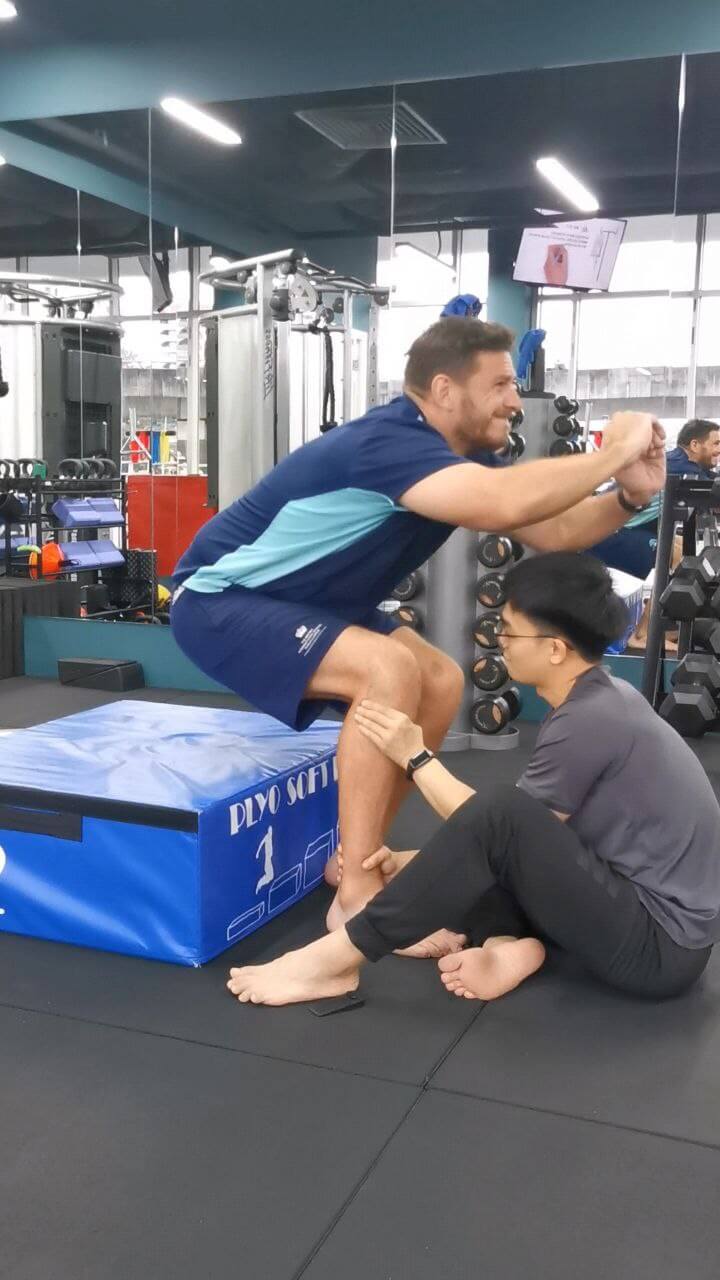
If knee pain is affecting your quality of life, visit our physiotherapy center in Mont Kiara, Kuala Lumpur, to receive an individualized treatment plan that addresses your specific condition and goals.
Exercises for Knee Pain
Regular exercises can help strengthen the knee, improve flexibility, and reduce pain. Here are three exercises for knee pain relief:
Straight Leg Raise
- Lie on your back with one leg bent and the other extended.
- Tighten your thigh muscle and slowly raise the extended leg to the height of the opposite knee.
- Hold for 5 seconds, then slowly lower back down.
- Perform 2–3 sets of 10–15 reps per leg. This exercise strengthens the quadriceps and helps support the knee.
Wall Squats
- Stand with your back against a wall, feet shoulder-width apart.
- Slowly slide down the wall until your knees are at a 90-degree angle.
- Hold for 5–10 seconds, then slide back up.
- Repeat 2–3 sets of 10 reps. Wall squats strengthen the thigh muscles without putting too much stress on the knee joint.
Calf Stretch
- Stand facing a wall, place one leg back with the heel on the ground, and the other leg forward.
- Lean into the wall, keeping your back leg straight to feel a stretch in your calf.
- Hold for 15–20 seconds, then switch legs.
- Perform 2–3 reps per leg. This exercise relieves tightness in the lower leg and helps prevent knee pain.
Practicing these exercises can alleviate pain and support the knee, but it’s essential to perform them under the guidance of a physiotherapist, especially if you have an underlying condition.
The video below shows Spanish Squat to strengthen your knees:
Prevention for Knee Pain
To prevent knee pain from recurring, consider these tips:
- Maintain a Healthy Weight
Extra weight puts added pressure on the knees, increasing the risk of injuries and pain. Maintaining a healthy weight reduces stress on the knee joints. - Warm-Up and Stretch Before Exercise
Warming up helps prepare the muscles, joints, and ligaments for activity, while stretching improves flexibility and reduces the likelihood of injury. - Strengthen the Surrounding Muscles
Strong muscles in the hips, thighs, and calves provide essential support to the knee, reducing the strain on the joint. Incorporate strength training exercises in your routine. - Wear Supportive Footwear
Proper footwear is essential for maintaining proper knee alignment. Choose shoes that offer adequate arch support and cushioning.
Conclusion
Knee pain when bending can significantly impact your mobility and quality of life, making it essential to address the issue early. With proper treatment, exercises, and preventive measures, you can manage or even prevent knee pain.
At ONI Physio Fitness, located in Mont Kiara, Kuala Lumpur, our team of experienced physiotherapists is here to help you relieve pain, improve joint function, and support your journey toward a pain-free life.
Don’t let knee pain hold you back. Visit ONI Physio Fitness in Mont Kiara, Kuala Lumpur, for a thorough assessment and effective treatment plan customized to your needs. Contact us today to book an appointment and start your journey toward better knee health.

